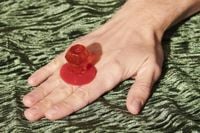In a significant shift for the U.S. food industry, Health Secretary Robert F. Kennedy Jr. announced on April 22, 2025, that the Department of Health and Human Services (HHS) and the Food and Drug Administration (FDA) will phase out petroleum-based synthetic food dyes from the nation’s food supply by the end of 2026. This announcement marks a major step in the administration's "Make America Healthy Again" initiative, aiming to enhance food safety and public health.
At a press conference, Kennedy, flanked by FDA Commissioner Dr. Marty Makary and food activists, detailed plans for the removal of eight synthetic dyes that have raised health concerns among consumers. The dyes targeted for elimination include Red 40, Yellow 5, and Blue 1, which are commonly found in various products such as breakfast cereals, candy, and beverages.
"For too long, some food producers have been feeding Americans petroleum-based chemicals without their knowledge or consent," Kennedy stated. He emphasized the need for transparency and safety in food production, asserting that these synthetic dyes pose real dangers to children’s health and development. "These poisonous compounds offer no nutritional benefit," he added.
The FDA's decision follows a growing body of research linking synthetic dyes to health issues, particularly in children. Notably, the California Office of Environmental Health Hazard Assessment reported in 2021 that synthetic food dyes are associated with hyperactivity and neurobehavioral problems in some children. This has led to calls for stricter regulations and a push for the use of natural alternatives.
Among the dyes being phased out, Red 40 is prevalent in popular products such as Gatorade, Doritos, and Skittles. Yellow 5 is commonly found in items like Fruit Loops and certain mustards, while Blue 1 is used in beverages like Mountain Dew Baja Blast. The FDA noted that the dyes are not just coloring agents but have been linked to various health risks.
Dr. Makary highlighted the urgency of the situation, stating, "We have a new epidemic of childhood diabetes, obesity, depression, and ADHD." He remarked that removing these artificial dyes would significantly contribute to improving children's health. The FDA is fast-tracking the review of natural alternatives to these synthetic dyes, aiming to provide regulatory flexibilities to industries transitioning to safer options.
The decision to remove synthetic dyes from food products is not without precedent. Earlier this year, the FDA banned Red 3, a dye known to cause cancer in laboratory rats, from foods and oral medications, giving manufacturers until 2027 to comply. This ban was a response to decades of lobbying and public demand for safer food products.
Consumer advocates have long criticized the use of synthetic dyes, arguing that their economic benefits do not outweigh the potential health risks. The dyes are cheaper and more stable than natural alternatives, making them appealing to manufacturers. However, studies have shown that some children may be more susceptible to the effects of these additives, leading to behavioral issues and other health concerns.
In 2012, a review linked Red 40 to multiple cancers, raising alarms among health professionals and parents alike. Despite the FDA's assurances that synthetic dyes are safe within established limits, concerns remain about their long-term effects, particularly on children.
As part of the new initiative, the FDA will revoke authorization for dyes not in production within the coming weeks and establish a timeline for the industry to switch to natural alternatives. This includes the immediate removal of Citrus Red No. 2 and Orange B, which are less commonly used but still present in some products.
The announcement has received mixed reactions from the food industry. The National Confectioners Association, representing candy manufacturers, expressed concerns about the proposal, stating that FDA and regulatory bodies have deemed their products safe. They emphasized the importance of rebuilding trust in the food safety system and eliminating consumer confusion.
However, Kennedy and Makary remain optimistic about the industry’s willingness to adapt. "To the companies currently using these dyes, try watermelon juice," Makary suggested, advocating for the use of natural colorings derived from fruits and vegetables.
As the U.S. moves towards eliminating synthetic dyes, it joins a growing list of countries that have implemented similar measures. In Europe, for instance, artificial colors are required to carry warning labels, prompting many manufacturers to switch to natural alternatives.
The implications of this decision extend beyond just food aesthetics. Kennedy pointed out that the use of synthetic dyes has been linked to academic performance and mental health issues in schools. The administration's commitment to phasing out these additives is seen as a crucial step in safeguarding children’s health and restoring public trust in the food supply.
In summary, the U.S. government’s initiative to phase out synthetic food dyes by 2026 is a bold move aimed at addressing health concerns and promoting safer food practices. As the regulatory process unfolds, the focus will be on ensuring that food companies transition smoothly to natural alternatives while maintaining product quality and consumer satisfaction.







